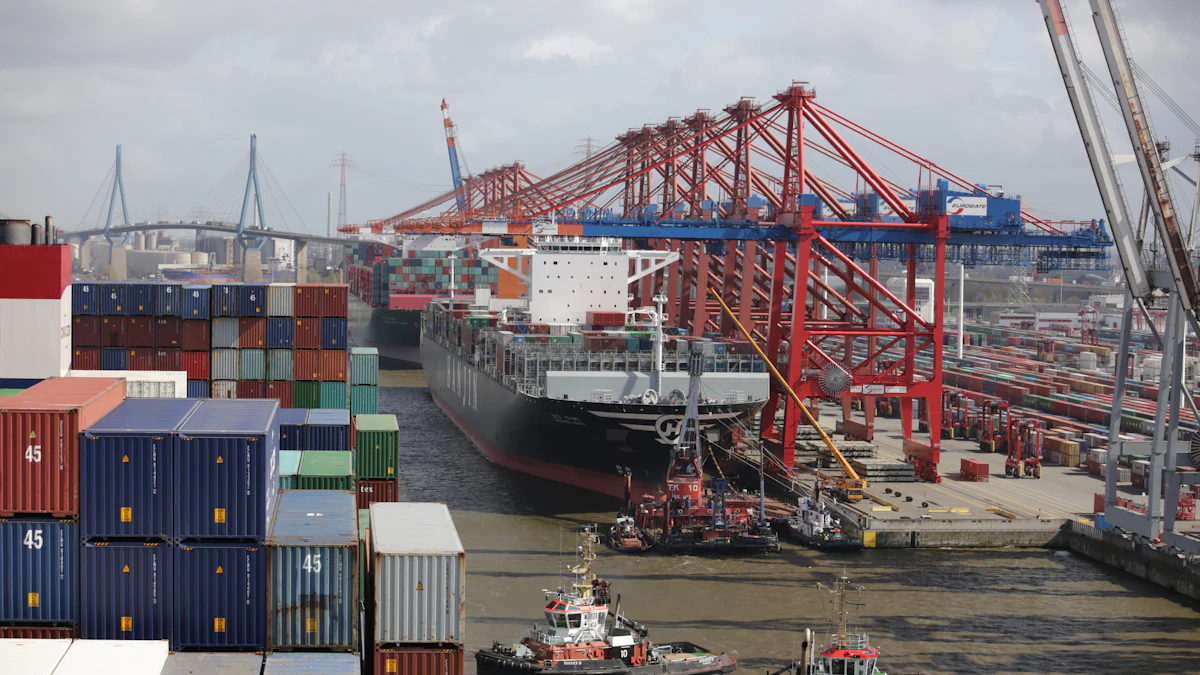The Meaning of Gross Vehicle Weight in Global Transport

Gross vehicle weight refers to the total weight of a vehicle, including its own weight, passengers, cargo, and any additional equipment. You must understand this concept because it directly impacts safety, logistics, and compliance. Managing gross vehicle weight ensures safer transport, prevents overloading, and improves fuel efficiency. It also plays a key role in logistics planning, especially for sea freight, by influencing route selection and reducing environmental impact.
Key Takeaways
Knowing gross vehicle weight (GVW) is important for safe driving.
Check your vehicle's GVW against its GVWR to stay safe.
Using JUSDA's smart logistics tools can help manage GVW better and make supply chains work well.
Understanding Gross Vehicle Weight and Its Components

What is Gross Vehicle Weight (GVW)?
Gross vehicle weight (GVW) refers to the total weight of a vehicle when it is fully loaded. This includes the weight of the vehicle itself, passengers, cargo, and any additional equipment. GVW is not a fixed number; it changes based on what the vehicle carries. For example, a car with only a driver will have a lower GVW than the same car loaded with passengers and luggage. Understanding GVW helps you assess whether a vehicle is operating within safe limits. It also ensures compliance with transportation regulations and prevents unnecessary wear on the vehicle.
Key Components of GVW: Curb Weight, Passenger Weight, and Cargo Weight
GVW consists of several components. The curb weight is the base weight of the vehicle, including all standard equipment, fluids, and a full tank of fuel, but without passengers or cargo. Passenger weight adds to the GVW based on the number of occupants and their average weight. Cargo weight includes everything the vehicle carries, from groceries to heavy machinery. Different vehicle classes contribute to GVW in unique ways. Passenger cars prioritize fuel efficiency and safety, while trucks and SUVs are built to handle heavier loads. Commercial vehicles, such as buses and delivery vans, have GVW tailored to their specific purposes. Trailers and RVs also factor in their own weight and the maximum payload weight they can carry.
How Gross Vehicle Weight is Calculated
To calculate GVW, you start with the curb weight of the vehicle. Add the weight of all passengers, including the driver. Then, include the weight of the cargo and any additional equipment. For example, if a vehicle has a curb weight of 4,000 pounds, carries four passengers weighing 150 pounds each, and hauls 500 pounds of cargo, the GVW would be 5,100 pounds. Always compare this number to the vehicle specifications to ensure it does not exceed the maximum weight limit. Staying within these limits protects the vehicle’s performance and ensures safety on the road.
Gross Vehicle Weight vs. Gross Vehicle Weight Rating (GVWR)
Differences Between GVW and GVWR
Understanding the distinction between gross vehicle weight and gross vehicle weight rating is essential for safe and efficient vehicle operation. While gross vehicle weight refers to the actual weight of a vehicle at a specific moment, gross vehicle weight rating represents the maximum weight a vehicle can safely handle as determined by the manufacturer. The table below highlights these differences:
Term | Definition |
|---|---|
Actual weight of a vehicle including cargo and passengers at a given time. | |
GVWR | Maximum weight a vehicle is designed to safely carry as specified by the manufacturer. |
You should always compare the GVW of your vehicle to its GVWR to ensure it does not exceed the recommended limit. This practice helps maintain vehicle safety and prevents damage to critical components like the suspension and braking systems.
Related Terms: Payload Capacity and Gross Weight
To fully grasp the concepts of GVW and GVWR, you need to understand related terms like payload capacity and gross weight. These terms are interconnected and play a vital role in vehicle performance and safety:
Gross vehicle weight rating includes the total weight of the vehicle's mass (curb weight) and any additional payload, such as passengers and cargo.
Manufacturers determine GVWR by evaluating the vehicle's frame, suspension, and braking capabilities.
Adhering to GVWR ensures the vehicle operates safely and maintains its structural integrity.
Gross weight, on the other hand, refers to the total weight of the vehicle when fully loaded. This includes passengers, cargo, and any additional equipment. Knowing the curb weight of your vehicle helps you calculate its payload capacity, which is the extra weight the vehicle can safely carry. Understanding these relationships ensures compliance with weight regulations and enhances overall safety.
The Role of GVW in Vehicle Safety and Performance

Impact on Braking, Handling, and Fuel Efficiency
Gross vehicle weight directly affects how your vehicle performs on the road. A lighter vehicle improves acceleration and handling, making it easier to navigate tight turns or sudden stops. It also shortens braking distances, enhancing safety. However, as the weight increases, you may notice reduced fuel efficiency. For every 1,000 pounds added, fuel economy can drop by about 0.5 percent. Heavier vehicles, such as light trucks or heavy-duty trucks, require more energy to move, which impacts their power-to-weight ratio. This means they consume more fuel and may feel less responsive when accelerating or steering. Keeping your vehicle within its gross vehicle weight rating ensures better control, improved fuel efficiency, and safer driving conditions.
Preventing Overloading and Ensuring Legal Compliance
Exceeding the gross vehicle weight rating can lead to serious safety implications. Overloading increases the risk of tire blowouts, especially in hot or high-speed conditions. It also compromises handling, making it harder to control your vehicle during emergencies. Over time, continuous overloading weakens the vehicle’s structure, reducing its ability to protect you in an accident. Braking systems may also fail under excessive weight, leading to longer stopping distances. By adhering to the payload capacity and GVWR, you reduce the likelihood of accidents and ensure compliance with legal weight limits. This practice not only protects you but also extends the lifespan of your vehicle.
Importance of GVW in Global Transport Logistics
Gross vehicle weight plays a critical role in global transport logistics. It helps prevent overloading, ensuring compliance with international regulations. Many roads have weight restrictions, so knowing your vehicle’s weight helps you select the right routes and avoid legal issues. Heavier vehicles consume more fuel, increasing costs and environmental impact. Optimizing cargo loads improves efficiency and sustainability. For example, light trucks used in urban deliveries benefit from staying within their payload capacity to reduce fuel consumption. In contrast, heavy-duty trucks transporting goods across long distances must balance weight and efficiency to minimize costs. Managing GVW effectively ensures smoother operations and safer transport.
Managing GVW in Global Transport with JUSDA
JUSDA’s Role in Optimizing Sea Freight and Logistics
You need efficient logistics solutions to manage gross vehicle weight effectively, especially in sea freight operations. JUSDA specializes in optimizing cargo loads to ensure compliance with the gross vehicle weight rating of transport vehicles. By balancing payload capacity and vehicle performance, JUSDA helps you reduce costs and improve efficiency. For example, JUSDA’s sea freight services focus on consolidating shipments to maximize container space while adhering to international weight regulations. This approach minimizes fuel consumption and enhances sustainability. With JUSDA’s expertise, you can streamline your supply chain and achieve seamless global transport.
Addressing International GVW Regulations and Challenges
Managing gross vehicle weight in global transport comes with challenges. Overloading creates safety risks, such as brake failure, tire blowouts, and reduced vehicle control. These issues increase the likelihood of accidents. You must also comply with strict weight regulations to avoid penalties and ensure safety. JUSDA addresses these challenges by offering tailored solutions for international logistics. Their advanced systems monitor weight limits across regions, helping you navigate complex regulations. By partnering with JUSDA, you can overcome these obstacles and maintain compliance in every stage of your supply chain.
JUSDA’s Innovative Solutions for Efficient Supply Chain Management
JUSDA leverages cutting-edge technology to optimize gross vehicle weight management. IoT sensors and RFID technology revolutionize how you monitor and manage weights. IoT sensors installed in containers provide real-time weight tracking, allowing you to adjust loads dynamically. RFID tags offer instant data on cargo weight, enhancing transparency and accuracy. JUSDA integrates these technologies into its JusLink intelligent supply chain platform, ensuring efficient operations. With these innovations, you can achieve precise weight management, reduce errors, and improve overall logistics performance.

JUSDA Solutions
To provide you with professional solutions and quotations.
Understanding gross vehicle weight (GVW) ensures safer transport and better vehicle performance. It prevents overloading, enhances handling, and ensures compliance with regulations.
Adhering to GVWR protects drivers and vehicles.
Accurate weight calculations improve logistics efficiency.
JUSDA’s innovative solutions simplify GVW management, ensuring seamless and compliant global transport.
Choose JUSDA for smarter logistics.
See Also
Discovering Top Global Logistics Firms: An In-Depth Guide
The Importance of Supply Chains in Global Trade Explained
Comprehensive Guide to Eco-Friendly Transportation in Supply Chains
Affordable Transportation Management: Your Budget's Best Ally
